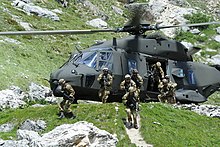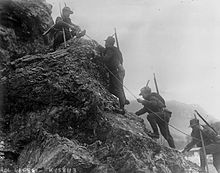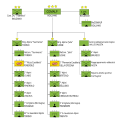Alpini

The Italian mountain hunters are called Alpini . They were founded in 1872 and are considered to be the oldest active mountain troop in the world.
As mountain troops, the Alpini are a sub-genus of the infantry of the Italian army . Along with the mountain artillery , the mountain pioneers and further to the mountain specialist troops of other weapons genres they are the Italian mountain troops ( troops alpine ). What they have in common is a special headgear, the so-called "Alpini hat", which is an expression of a strong corps spirit .
The Mountain Troops Command in Bolzano ( Comando Truppe Alpine - COMALP ) is currently subject to two mountain brigades with a total of eight Alpini- regiments in battalion strength . With one exception, these regiments are stationed in the Italian Alpine region . Since the end of the Cold War, which is national defense receded into the background. The mountains serve as the basis for preparation for international missions in difficult terrain and under extreme weather conditions.
history

precursor
The mountain militias of the Piedmontese army can be regarded as the more distant predecessors of the Alpini . These were used against France in the western Alps in the 17th and 18th centuries . The Bersaglieri (" Riflemen "), set up in 1836, served as light infantry until the founding of the Alpini as mountain troops. In 1859 the "Alpine hunters" ( Cacciatori delle Alpi ) fought as a free group under Garibaldi during the Risorgimento . Since they were incorporated into the Italian line infantry in 1861 , they only have an indirect reference to the Alpini.
founding
In 1872, 15 alpine companies were set up to defend the Alpine border. In 1878 there were already ten battalions , and the first regiments were formed from 1882 . By 1914, eight Alpini regiments, numbered from west to east, with 26 active battalions as a peace force , had been established from the Maritime Alps to the Julian Alps . The active battalions bore the names of mountain areas, those of the reserve in the first category the names of mountains, those of the second category those of mountain valleys ("mobile and territorial militia", " Landwehr "). Due to the historical development, the companies were consecutively numbered, that is, each company had (and still has) its own number regardless of the superordinate association. In 1877 the first mountain artillery batteries were installed.
As long as conscription existed, the Alpini, unlike the line infantry, were recruited locally, usually in the Alps, but also in some areas of the Apennines . It was a tradition to call up suitable conscripts from a district to the Alpini on the same dates every year and to assign them to a battalion as a whole after completing their training. This led to a very strong bond between the Alpini associations and their recruiting areas.
First World War
In the course of the First World War , the number of Alpini battalions rose to 88 with a total of 274 companies. These included battalions with special tasks, such as ski battalions. The higher regiments at that time only served administrative purposes. The battalions were assigned to various large formations and combined into combat groups. Towards the end of the war the Alpini were concentrated in four divisions (5th, 52nd, 75th, 80th), which, in contrast to the other infantry divisions, were called mountain divisions.
Depending on the terrain and the high alpine difficulties, the Alpini mostly operated in the form of small attack troops. The Adamello Group , the Pasubio , the Dolomites (including the Marmolada , the Tofanen , the Passo della Sentinella) and the Monte Nero (Krn) were the scenes of more important missions . The loss-making battles of the 52nd Division on Monte Ortigara are a symbol of the willingness of the troops to make sacrifices, even with obvious misjudgments by the higher command. At the end of 1917, the Alpini made a decisive contribution to the defense of the strategically important grappa stick . Numerous other battles established the reputation of the Alpini as an excellent mountain troop during this time. However, they were unable to achieve strategic successes in the Alps, also because the terrain favored the defenders significantly.
Interwar period
After the First World War, the Alpini regiments and their battalions were formed into closed combat units. In 1921 a 9th Alpini Regiment was created, which was initially intended for the Julian Alps, but which was later assigned to the central Italian Abruzzo as a recruiting and stationing area . The fictitious 10th Alpini Regiment is still the unofficial name of the Associazione Nazionale Alpini , an association of active Alpini and reservists . In 1935, because of the war in East Africa, regiments 11 and 12 were created (the latter until 1937).
In 1923 the Alpini regiments were merged into three groups, which in 1926 were given the name " Brigades ". In the Western Alps, regiments 1 to 4 together with the 1st Mountain Artillery Regiment formed the 1st Brigade. The 2nd Brigade with Regiments 5, 6 and 7 and the 2nd Mountain Artillery Regiment were in South Tyrol and the Dolomites . The 3rd Brigade was responsible for the Carnic and Julian Alps with regiments 8 and 9 and the 3rd mountain artillery regiment . In 1935, five divisions emerged from these "brigades" :
- 1st Alpini Division Taurinense in Turin (3rd and 4th Alpini Regiment in Pinerolo and Aosta , 1st Mountain Artillery Regiment in Turin)
- 2nd Tridentina Alpini Division in Merano (5th and 6th Alpini Regiments in Merano and Sterzing , 2nd Mountain Artillery Regiment in Merano)
- 3rd Alpini Division Julia in Udine (8th and 9th Alpini Regiment in Udine and Görz , 3rd Mountain Artillery Regiment in Udine)
- 4th Alpini Division Cuneense in Cuneo (1st and 2nd Alpini Regiment in Mondovì and Cuneo, 4th Mountain Artillery Regiment in Cuneo)
- 5th Alpini Division Pusteria in Bruneck (7th and 11th Alpini Regiment in Belluno and Bruneck, 5th Mountain Artillery Regiment in Belluno)
At the end of 1941, a 6th Alpini Division Alpi Graie ( Ivrea ) was added, which was mainly used against partisans in Yugoslavia . She led reserve units and the 6th Mountain Artillery Regiment.
Second World War
Even in World War II , the Alpini regiments showed that they were in no way inferior to comparable formations of other armed forces. In the disastrous Italian campaign against Greece , the Alpini division Julia stood out in the Pindos Mountains. However, their isolated advance soon put them in an untenable position. In September 1942, at Mussolini's request, an entire Alpine Army Corps was sent to the Russian steppe as part of the Italian 8th Army . It consisted of the Alpini divisions Tridentina , Julia and Cuneense . On January 13, 1943, it was cut off by the Red Army during a battle on the Don . Behind the front it fought uninterruptedly against superior Soviet forces for two weeks in a severe frost , until it prevailed in the battle of Nikolaevka on January 26 with enormous losses and was able to rejoin German troops by the end of the month .
After the armistice announced on September 8, 1943, the Alpini split up. Some fought in partisan groups against the German occupation forces in Italy and in the Balkans . In Montenegro , among other things, the Garibaldi partisan division emerged from the Taurinense division . Three battalions fought with the Allies in southern Italy. In the fascist social republic in northern Italy, which was allied with Germany, the Alpini division Monterosa was formed in early 1944 . It consisted of two Alpini regiments (a third remained independent) and a mountain artillery regiment. The division fought back allied forces (92nd US Division) in the Apuan Alps together with German units at the end of 1944 .
Cold War
Between 1949 and 1953 five Alpini brigades were set up, some with the old division names:
- Taurinense in Turin (4th Alpini Regiment in Turin, 1st Mountain Artillery Regiment in Rivoli )
- Orobica in Meran (5th Alpini Regiment in Meran, 5th Mountain Artillery Regiment in Meran)
- Tridentina in Brixen (6th Alpini regiment in Bruneck , 2nd mountain artilleryregimentin Bozen )
- Cadore in Belluno (7th Alpini Regiment in Belluno, 6th Mountain Artillery Regiment in Belluno)
- Julia in Udine (8th Alpini Regiment in Tolmezzo , 3rd Mountain ArtilleryRegimentin Udine, Gemona )
They were subordinate to the IV (Alpine) Corps in Bozen. During the Cold War, the latter had the task of repelling a possible attack by Warsaw Pact armed forces in the Italian Eastern Alps . The Alpini Brigade Taurinense , intended as a reserve, provided NATO with a unit for the Allied Mobile Force - Land (AMF-L), which frequently practiced in Norway , for many years . The contingent called Cuneense consisted of an Alpini battalion, an artillery battery, a medical unit and smaller support units.
With the army reform of 1975, the regimental level was abolished in Italy. The battalions were then directly subordinate to the brigades. At the beginning of the 1990s, the Alpini battalions again took on the name regiment for reasons of tradition, but still only have battalion strength.
reduction

|

|
|
|
Soldiers of the 32nd Mountain Spy Regiment (Turin) in Afghanistan
|
Alpini of the 4th Rgt. In Afghanistan
|
Due to the new global political situation, the Alpini Brigade Orobica in Meran was dissolved in 1991 , the Cadore in Belluno in 1997 , and finally the Tridentina in Brixen in 2002 . In 1997 the IV Mountain Corps in Bozen ( Gries-Quirein ) became the Mountain Troop Command ( Comando Truppe Alpine - COMALP). Since 2002 COMALP has been subordinate to the Tridentina division command, which is intended for foreign missions , as well as the two remaining brigades Taurinense in Turin (2nd, 3rd and 9th Alpini Regiment) and Julia in Udine (5th, 7th and 8th Alpini Regiment) the mountain and winter combat training center in Aosta with the partially active 6th Alpini regiment entrusted with training tasks in Pustertal . The 4th Alpini Parachute Regiment , which was moved from Bolzano to Verona in 2010, was directly under COMALP for a long time. Since 2013 this regiment has been under the army's new special forces command . All remaining active Alpini regiments have been deployed abroad in recent years, particularly in Afghanistan .
Alpini in the professional army
Since the suspension of compulsory military service in 2005, volunteers (teams) can initially undertake a one-year service period and then extend it for a further four years if necessary. The professionalization of the Italian armed forces initially brought problems for the Alpini, as not enough volunteers from the Alpine valleys were available. The regulation, according to which applicants are only admitted to the Carabinieri and other police and civil defense forces if they have previously signed up “voluntarily” in the army, brought relief, as did a “pay allowance” for the mountain troops. Many former members of the Alpini today complain that the new applicants are no longer mainly from northern Italy and that the traditional spirit of the corps is being undermined. Due to the constant foreign missions with their often more police-like requirements, the actual character of the Alpini as a high mountain force is increasingly blurred and ultimately any light infantry force is created. Others point out that these arguments are mainly put forward by the influential Associazione Nazionale Alpini , because they want to preserve the special regional character of the troop and thus also their own club life, which is shaped by northern Italy. The military and also the Alpini, on the other hand, have to meet today's requirements, and training practice shows that you are not born a mountain hunter, but that training determines the value of the troops. After the end of the Cold War, training had to be geared to the new asymmetrical threat situation.
uniform
The special headgear of the Alpini was introduced in March 1873. It was based on models worn during the popular uprisings of 1848 in Venice , Milan and in Cadore . The hat at that time was melon-shaped and made of black felt .
With the gray-green uniform, the Alpini hat was introduced in 1910 in its version that is still used today. In front is the emblem of the branch of arms with the regimental number. The Alpini are an eagle with a hunting horn and crossed rifles, the other mountain troops have instead of rifles, for example, crossed cannon barrels (mountain artillery), axes (mountain pioneers) or other symbols typical for the respective mountain troop type. The emblem was originally gold-colored only for officers , otherwise black. Only temporary soldiers in team ranks have black emblems today.
On the left side of the hat, officers and NCOs with portepee can see special versions of the rank badges. These are stars for generals, otherwise a system of angles.
In addition, there is the traditional nib, which is generally black but is white for staff officers and generals . The holder of the pen is adorned with a small tassel, the color of which - white, red, green, blue - provides information about the membership of teams in the first to the fourth battalion of a regiment. Due to the downsizing of the force, this system is only used to a limited extent today. Other colors or color combinations (including letters or numbers) are used by various other mountain troop members and staffs. In the case of NCOs and officers, the bracket is only made of metal.
The traditional alpine hat is now usually only worn with a service suit, while a combat suit is worn with a mountain hat, which is very similar to that of the German mountain troops . In contrast to all other branches of the Italian army, the Alpini do not have a beret . On the steel helmet , the Alpini fix its spring until today.
The Alpini have been wearing green collar tabs with their uniforms since 1883 . For the other mountain troops, the colors of their actual weapon type (artillery, pioneers, telecommunications, etc.) are combined with the green of the Alpini.
museum

In Trento , the military maintains the Museo Nazionale Storico degli Alpini . There are also a number of museums dedicated to the Alpini. These museums are mostly run by the Associazionale Nazionale Alpini .
Picture gallery
Mountain artillery emblem
See also
- List of Italian regiments (Alpini)
- List of major Italian associations
- Military equipment in the First World War
literature
- Laurent Mirouze: Infantrymen of the First World War . Dissberger, Düsseldorf 1990, ISBN 3-924753-28-8 .
Web links
- Official website (Italian)
- Associazione Nazionale Alpini (Italian)

























